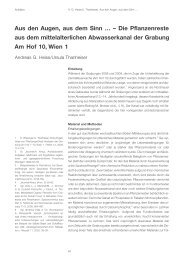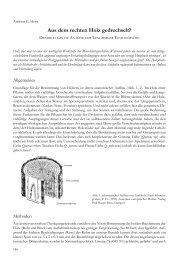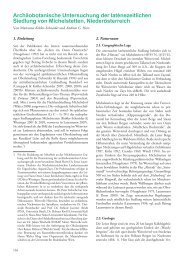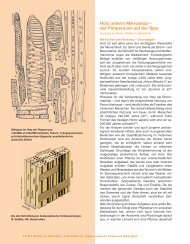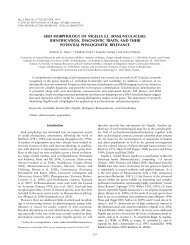View - erbsenzaehler.at
View - erbsenzaehler.at
View - erbsenzaehler.at
You also want an ePaper? Increase the reach of your titles
YUMPU automatically turns print PDFs into web optimized ePapers that Google loves.
Medieval and l<strong>at</strong>er comment<strong>at</strong>ors alike; also the survival<br />
of the word in the form “kizḥa” in Palestinian<br />
vernacular Arabic points in the same direction (Löw<br />
1924, 120–123; see also below). However, it is only in<br />
the cuneiform sources from Mesopotamia th<strong>at</strong> one<br />
finds good contextual evidence for the cultiv<strong>at</strong>ion of<br />
Nigella and for its use for culinary and, to a lesser<br />
degree, medical purposes from the l<strong>at</strong>e 3rd millennium<br />
BC until the l<strong>at</strong>e 1st millennium BC. In fact, the<br />
Ancient Near East has produced the richest body of<br />
ancient textual evidence th<strong>at</strong> can be brought to bear<br />
on the present topic, and an unusually strong case<br />
for a positive identific<strong>at</strong>ion of the Ancient (Sumerian<br />
and Akkadian, i. e. Babylonian and Assyrian) plant<br />
name(s) with the genus Nigella and even specifically<br />
N. s<strong>at</strong>iva can be made – a case th<strong>at</strong> is based not only<br />
on etymology, as is commonly the case with Ancient<br />
Near Eastern (and generally ancient Semitic) plant<br />
names, but also based on context.<br />
Starting points are the Akkadian plant names<br />
“kamūnu” and “zibibiānu”, the l<strong>at</strong>ter with its variants<br />
“zibû”, “sabibiānu”, “šibibānu” etc. (in the following,<br />
we will always use the variant th<strong>at</strong> is <strong>at</strong>tested in<br />
the source in question). These words do not have Semitic<br />
etymologies in the sense th<strong>at</strong> they are not of Semitic<br />
origin, r<strong>at</strong>her, they are ancient Wander- or Kulturwörter.<br />
The first corresponds to Arabic “kammūn”,<br />
Hebrew “kammōn”, Syriac “kammūnā” (cumin,<br />
Cuminum cyminum), this word itself being of course<br />
a loan of the same origin in all modern European languages<br />
(via Greek). “Zibibiānu” etc. etymologically<br />
corresponds to Syriac “šbūbānā” (and variants),<br />
which is equ<strong>at</strong>ed in various traditions with Hebrew<br />
“qeṣaḥ” and Arabic “šūnīz”, the l<strong>at</strong>ter of which is a<br />
synonym of “kammūn aswad” (black kammūn). Medieval<br />
Hebrew and Western early modern as well as<br />
modern comment<strong>at</strong>ors take all these words to design<strong>at</strong>e<br />
Nigella (locus classicus: Löw 1924, 120–123). The<br />
etymologies of the Akkadian words were recognized<br />
early on, and they have thus generally been transl<strong>at</strong>ed<br />
as “cumin” and “black cumin” (N. s<strong>at</strong>iva) respectively<br />
(e. g. von Soden 1965–1981, 434; 1524; Landsberger/Gurney<br />
1957/58, 336; Thompson 1949, 69–72).<br />
The context of the <strong>at</strong>test<strong>at</strong>ions of “zibibiānu” etc.<br />
bears out the etymological argument. The earliest evidence<br />
comes from the second half of the 3rd millennium<br />
BC and is in Sumerian. In administr<strong>at</strong>ive texts<br />
of the period one encounters the condiment “gamun”<br />
(e. g. Steinkeller/Postg<strong>at</strong>e 1992, 77). This word is<br />
of the same origin as the slightly younger “kamūnu”.<br />
“Gamun” comes in two variants: “white” (babbar),<br />
and “black” (gi 6<br />
) (e. g. Schneider 1931, no. 64: 7–8).<br />
The cuneiform signs used to write the loan word<br />
“gamun”, viz. (Ú-ŠE+NUN.NUN-SAR or Ú-DIN-<br />
ŠE+NUN.NUN-SAR) indic<strong>at</strong>e th<strong>at</strong> garden plants<br />
(Ú … SAR) characterized by their grainy seeds (ŠE)<br />
are meant, or r<strong>at</strong>her, the seeds of these plants. In<br />
some scribal traditions of l<strong>at</strong>e 3rd millennium BC<br />
Sumerian, e. g. in the city of Girsu, the pair “white/<br />
black gamun” is given as (unqualified) “gamun” and<br />
“zibum” or “zibibianum” – the l<strong>at</strong>ter corresponding<br />
of course to the Akkadian words “zibû”/“zibibiānu”<br />
(e. g. Maekawa 1993, 123 no. 94 ii: 11–12; iii: 4–5; vi:<br />
5–6). The interpret<strong>at</strong>ion of “zibibiānu” as “black gamun/kamūnu”<br />
also re-occurs in the n<strong>at</strong>ive Babylonian<br />
lexical tradition of the 2 nd and 1st millennium BC<br />
(e. g. Thompson 1949, 70–71; Landsberger/Reiner<br />
1970, 94: 300–303). The fact th<strong>at</strong> the black seeds were<br />
the principal product of the plant follows also from<br />
medical recipes which indic<strong>at</strong>e th<strong>at</strong> “zibû” had to be<br />
ground with a pestle or a handmill (e. g. von Soden<br />
1965–1981, 1525; Salonen 1965, 53).<br />
In the l<strong>at</strong>e 3rd millennium BC, the black and white<br />
“gamun” were cultiv<strong>at</strong>ed in southern Mesopotamia<br />
in special spice gardens (Maekawa 1985, 99; 112) together<br />
with coriander and legumes. From l<strong>at</strong>er periods<br />
there is only some sc<strong>at</strong>tered evidence for the cultiv<strong>at</strong>ion<br />
of “kamūnu” in the south (e. g. Stol 1986, 61;<br />
98), and we do not hear of the cultiv<strong>at</strong>ion of “zibû”,<br />
even though the use of the seeds continues in this region.<br />
After the 3rd millennium, explicit <strong>at</strong>test<strong>at</strong>ions<br />
for the cultiv<strong>at</strong>ion of “zibibiānu” (“sabibiānu”) are<br />
only available for northern Mesopotamia. Evidence<br />
comes from the Khabur region (Röllig/Tsukimoto<br />
1999, 436: note the absence of “kamūnu” in this context)<br />
and from the region around modern Kirkuk<br />
(Zaccagnini 1979, 128). Since the bulk of the evidence<br />
for the use of “zibibiānu” is also from northern<br />
Mesopotamia, it is probable th<strong>at</strong> the plant was<br />
cultiv<strong>at</strong>ed and used predomin<strong>at</strong>ely in this region,<br />
while the seeds used for culinary and medical purposes<br />
in the south were possibly imported (cf. Reynolds<br />
2007, 178).<br />
Medical use of “zibû” involves usually braying<br />
the seeds in a mortar and mixing them with a f<strong>at</strong>ty<br />
substance, or with barley beer. It is used for mouth<br />
or tooth disorders, but also for other internal problems<br />
(Thompson 1949, 70–71). Culinary use is much<br />
better documented. In the l<strong>at</strong>e 3rd millennium BC,<br />
the “gamun” varieties are well <strong>at</strong>tested as culinary<br />
ingredients (e. g. Brunke 2011, 198; 219). From l<strong>at</strong>er<br />
periods, rich bodies of evidence come again from<br />
northern Mesopotamia. In the city of Mari on the<br />
middle Euphr<strong>at</strong>es, “zibû” was an important spice<br />
th<strong>at</strong> was used side by side with “kamūnu”. The two<br />
were important ingredients of the sumptuous mersu<br />
cake, in addition to flour, f<strong>at</strong>, d<strong>at</strong>es and other<br />
fruit, as well as garlic and coriander (Bottéro 1995,<br />
23–24), but they were also used for other me<strong>at</strong> and<br />
vegetable dishes (Sasson 2004). Also in the city of<br />
Alalakh, further to the west, “zibû” was much in demand<br />
(Zeeb 2001, 193–194), and it is also <strong>at</strong>tested<br />
in the 13th century BC in the city of Ugarit on the<br />
northern Mediterranean coast in the local alpha-<br />
151



